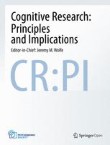Cognitive Research: Principles and Implications is affiliated with The Psychonomic Society
Confidence guides spontaneous cognitive offloading
Cognitive offloading is the use of physical action to reduce the cognitive demands of a task. Everyday memory relies heavily on this practice; for example, when we write down to-be-remembered information or us...
